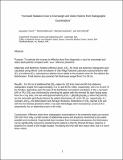Increased Radiation Dose to Overweight and Obese Patients from Radiographic Examinations
Author(s)
Behrman, Richard; Hendricks, Michael; McCall, John; Yanch, Jacquelyn C
DownloadYanch_Increased Radiation Dose.pdf (417.6Kb)
OPEN_ACCESS_POLICY
Open Access Policy
Creative Commons Attribution-Noncommercial-Share Alike
Terms of use
Metadata
Show full item recordAbstract
Purpose: To estimate the increase in effective dose from diagnostic x-rays for overweight and obese adult patients compared with „lean‟ reference phantoms. Materials and Methods: Relative effective doses, E/E[subscript 0], for chest and abdomen radiographs were calculated using Monte Carlo simulation of Oak Ridge National Laboratory adult phantoms with (E), and without (E[subscript 0]), subcutaneous adipose tissue added to the phantom torso for five distinct fat distributions. Total anterior plus posterior fat thicknesses ranged from 0 to 38 cm. Results: For 30 cm of additional fat E/E[subscript 0] values for 120 kVp chest and 80 kVp abdomen radiographs ranged from approximately 2 to 31 and 83 for males, respectively, and 2 to 45 and 76 for females, depending upon the type of fat distribution and patient orientation in the x-ray beam (AP or PA). E/E[subscript 0] was minimized by orienting the patient with the thinnest fat layer facing away from the x-ray tube, and was well approximated by E/E[subscript 0] = [B(t)/B[subscript 0]]exp(kt[subscript DF]) where B(t) and B0 are the antiscatter grid Bucky factors for patient thicknesses of t and t=20 cm, respectively, k a constant, and t[subscript DF] the distal (beam exit) fat layer thickness. Reductions in E/E[subscript 0] reached 14% and 20% for the thickest phantoms when x-ray tube kilovoltages were increased by 10 and 20 kV, respectively, for an abdominal exam in the male. Conclusions: Effective doses from radiographic examinations in the extremely obese can exceed 100 mSv from only a small number of abdominal exams and should be minimized to the extent possible and monitored. Exponential dose increases from increased subcutaneous fat thicknesses can be significantly reduced by positioning the patient so that the thinnest fat layer (anterior or posterior) is closest to the image receptor. Increasing the kVp will also reduce dose, but to a much lesser extent.
Date issued
2009-07Department
Massachusetts Institute of Technology. Department of Nuclear Science and EngineeringJournal
Radiology
Publisher
Radiological Society of North America
Citation
Yanch, Jacquelyn C. et al. “Increased Radiation Dose to Overweight and Obese Patients from Radiographic Examinations1.” Radiology 252.1 (2009): 128-139.
Version: Author's final manuscript
ISSN
0033-8419
1527-1315